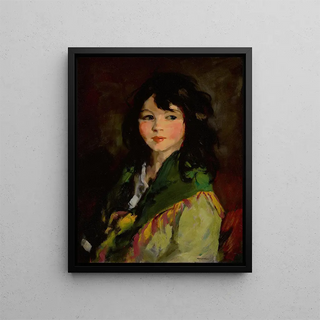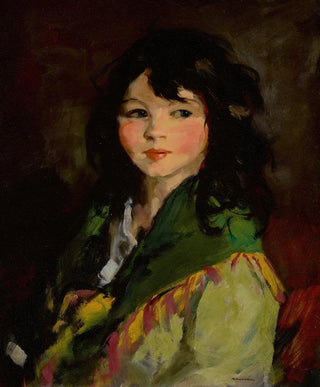Art print | Francine Lovey - Robert Henri


View from behind

Frame (optional)
At the heart of the early 20th-century art universe, "Francine Lovey - Robert Henri" stands out as an emblematic artwork, revealing the richness and depth of human emotions. This painting, vibrant with life, captures the very essence of its subject, Francine Lovey, whose gaze seems to convey a personal story, a palpable intimacy. In this piece, Robert Henri, a major figure of the American realist movement, succeeds in transcending a simple portrait to offer a true exploration of the human soul. The light, colors, and expressions combine to create an atmosphere that is both delicate and powerful, immersing the viewer in a silent dialogue with the model.
Style and uniqueness of the artwork
Robert Henri's style is distinguished by his ability to blend a mastered technique with a deeply human approach. In "Francine Lovey," he employs bold and expressive brushstrokes that bring the canvas to life while maintaining a certain softness in rendering his model's features. The chosen color palette evokes a warm, almost intimate ambiance, where each nuance contributes to the visual storytelling. Henri does not merely depict a face; he explores the nuances of emotion, the fragility of the moment, and the beauty of everyday life. Every detail, from the gaze to the shadows, is carefully considered to invite the viewer to reflect on Francine Lovey's inner world, making this artwork a true window into the soul.
The artist and his influence
Robert Henri, born in 1865, is often regarded as one of the pioneers of the realist movement and a leading figure of the Ashcan School, which advocated for an authentic representation of urban life. His innovative approach influenced many contemporary and future artists, emphasizing the importance of personality and individuality in art. Henri firmly believed that art should reflect life as it is, with its beauties and imperfections. His work with models from diverse social backgrounds enriched his oeuvre, allowing him to explore universal themes such as identity, solitude, and human connection. In painting "Francine Lovey," he does not merely depict a woman,

Matte finish

View from behind

Frame (optional)
At the heart of the early 20th-century art universe, "Francine Lovey - Robert Henri" stands out as an emblematic artwork, revealing the richness and depth of human emotions. This painting, vibrant with life, captures the very essence of its subject, Francine Lovey, whose gaze seems to convey a personal story, a palpable intimacy. In this piece, Robert Henri, a major figure of the American realist movement, succeeds in transcending a simple portrait to offer a true exploration of the human soul. The light, colors, and expressions combine to create an atmosphere that is both delicate and powerful, immersing the viewer in a silent dialogue with the model.
Style and uniqueness of the artwork
Robert Henri's style is distinguished by his ability to blend a mastered technique with a deeply human approach. In "Francine Lovey," he employs bold and expressive brushstrokes that bring the canvas to life while maintaining a certain softness in rendering his model's features. The chosen color palette evokes a warm, almost intimate ambiance, where each nuance contributes to the visual storytelling. Henri does not merely depict a face; he explores the nuances of emotion, the fragility of the moment, and the beauty of everyday life. Every detail, from the gaze to the shadows, is carefully considered to invite the viewer to reflect on Francine Lovey's inner world, making this artwork a true window into the soul.
The artist and his influence
Robert Henri, born in 1865, is often regarded as one of the pioneers of the realist movement and a leading figure of the Ashcan School, which advocated for an authentic representation of urban life. His innovative approach influenced many contemporary and future artists, emphasizing the importance of personality and individuality in art. Henri firmly believed that art should reflect life as it is, with its beauties and imperfections. His work with models from diverse social backgrounds enriched his oeuvre, allowing him to explore universal themes such as identity, solitude, and human connection. In painting "Francine Lovey," he does not merely depict a woman,






